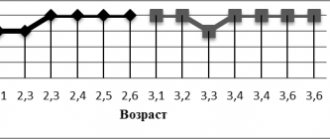Children with mental retardation: developmental features, learning requirements.
Catalog of All-Russian pedagogical competitions
All-Russian pedagogical conferences
Apply for publication of original material in the media
Program of International Pedagogical Competitions
Advanced training programs for teaching staff
author: Kuznetsova Albina Khasmullaevna
Primary school teacher MCOU "Special correctional boarding school No. 152", Novosibirsk
Children with mental retardation: developmental features, learning requirements.
Children with mental retardation: developmental features, learning requirements.
The development of cognitive processes of children studying in a correctional school is an important condition for correctional education. This is explained by social and humanistic trends in modern society, throughout the world and in Russia in particular. A mentally retarded child is characterized by researchers as a general underdevelopment and mental abilities are naturally formed in him with great delays. Society must ensure that such a child grows up and enters adulthood without any problems. To do this, it is necessary to study in detail the issues of the formation of cognitive processes and interest in learning in children with intellectual disabilities.
The cognitive processes of mentally retarded children are formed in conditions of defective sensory cognition, speech underdevelopment, limited practical activity, therefore their mental operations develop slowly and have unique features.
Such domestic scientists as L.V. Zankov, A.I. Lipkina, E.M. Kudryavtseva, I.M. Solovyov, Zh.I. studied the cognitive processes of mentally retarded children. Schiff, M.S. Pevzner and many other authors.
The concept of a mentally retarded child
includes a very heterogeneous group of children who are united by the presence of brain damage.
In accordance with the International Classification of Diseases, 10th revision (ICD - 10):
Mental retardation
- these are states of delayed or incomplete development of the psyche, which is primarily characterized by a violation of abilities that manifest themselves during the period of maturation and provide the general level of intelligence, i.e. cognitive, speech, motor and social abilities.
Other sources define the term mental retardation as follows:
Mental retardation
- this is a persistent, irreversible impairment of cognitive activity, all mental functions with particular underdevelopment of abstract and logical thinking, arising as a result of organic damage to the brain.
Causes of mental retardation
- Endogenous (or internal) causes are divided into three groups:
- prenatal (before the birth of the child): this can be a mother’s illness, nervous breakdowns, injuries, heredity;
- natal (the moment of childbirth): this could be a difficult birth, too fast a birth, or medical intervention;
- postnatal (after birth): for example, the child bumped or fell.
- Exogenous (or external) reasons: reasons of a socio-biological nature - this is the environment, tobacco smoking, drug addiction, alcoholism, AIDS.
Defect structure:
Irreversible underdevelopment of the brain with a predominantly immature cortex
Underdevelopment of mental activity itself
Underdevelopment of motivational-volitional and emotional components
Insufficiency of higher mental functions
Children with mental retardation are characterized by persistent disturbances in all mental activity, especially clearly manifested in the sphere of cognitive processes. Moreover, there is not only a lag from the norm, but also a deep originality of both personal manifestations and cognition. Thus, the mentally retarded cannot in any way be equated with normally developing children of a younger age.
Such children are capable of development, although development is slow, but it makes qualitative changes in the mental activity of children, in their personal sphere.
Features of cognitive processes of mentally retarded schoolchildren:
Pathological inertia of nervous and mental processes;
Intellectual passivity, indifference to what is happening;
Decreased motivation for activity;
Stiffness, inertia and stereotypical thinking;
Impaired critical thinking;
Violation of the operational and organizational components of mental activity;
Insufficiency, undifferentiation and poverty of perception;
Low accuracy and strength of memorization;
Unintentional memorization;
Speech disorders;
Low focus of activity
Sensation and perception
Visual perception
students slowly. This means that in order to see and recognize a familiar object, primary school students need more time than their normally developing peers. This is an important feature that has a certain influence on children’s orientation in space and, probably, on the process of learning to read.
Perception is characterized by undifferentiation. When examining an object, children see it in general terms, without noticing specific features. It is especially difficult for mentally retarded children to actively adapt their perception to changing conditions. They incorrectly recognize inverted images of well-known objects, mistaking them for other objects in their usual position. A special issue is the perception of plot paintings by schoolchildren.
With a mild degree of UI: The volume of visual perception is narrowed, orientation is difficult.
With a moderate degree of disability: the development of the visual, auditory, tactile analyzers lags behind, anomalies of vision and hearing, and does not orient independently in the situation.
In severe degrees of MR: Perception is superficial, surrounding objects are perceived and differentiated satisfactorily.
With a deep degree of UO: The psyche is at low stages of development, it is difficult to navigate, and cannot distinguish edible from inedible.
Attention and memory
Researchers emphasize the essential role of attention in the performance of educational and work activities. Among the main disadvantages of attention
Mentally retarded schoolchildren have impaired concentration, stability, distribution, switchability and attention span. In students with intellectual disabilities, involuntary attention is somewhat more preserved than voluntary attention, but it is also unique. The attention of a mentally retarded child is directly dependent on the characteristics of his performance.
Education for mentally retarded children relies more on memory processes,
which has many unique features. The amount of material memorized by students with disabilities is significantly less than that of their typically developing peers.
Thus, students remember rows of words less successfully than rows of pictures.
The accuracy and strength of memorization of both verbal and visual material is low.
Memorizing texts, even simple ones, suffers from imperfection among schoolchildren, since they are not sufficiently able to divide the material into paragraphs, highlight the main idea, identify supporting words and expressions, establish semantic connections between parts, etc. As a result, students retain only part of the material in their memory.
A very characteristic feature of students with learning disabilities is their inability to use well-learned material and reproduce the knowledge that is necessary to solve the specific task assigned to them.
It is essential to characterize the memory of mentally retarded students, as well as to substantiate a favorable prognosis for their development, that they are able to remember material that they understand with great success.
With a mild degree of UO: The amount of attention is reduced, the concentration of attention is worse, voluntary attention is unstable; not stable memorization, rapid forgetting, mechanical memory is formed.
With a moderate degree of ES: Unstable attention, memory is insufficiently developed, voluntary memorization is impaired, mechanical memory suffers.
In severe cases of MR: Attention is seriously impaired, memory capacity is low.
With a deep degree of MR: Attention and memory are not developed.
Thinking
Thinking
- a generalized, indirect reflection of the external world and its laws, a socially conditioned process of cognition, its highest level. It is carried out using mental operations (analysis, synthesis, generalization, classification, abstraction, comparison).
It has sequentially arising in the child’s ontogenesis and then interacting practically effective, visual-figurative and verbal-logical forms.
Mentally retarded primary schoolchildren exhibit insufficiency at all levels of mental activity. They are made difficult by solving the simplest practical problems, such as combining an image of a familiar object cut into 2-3 parts, or choosing a geometric figure identical in shape and size to the given one.
Students in grades 1-2 experience even greater difficulties in tasks involving the use of visual-figurative thinking. The greatest difficulty is presented by tasks that require students to use verbal and logical thinking, such as understanding simple texts containing certain dependencies - temporary, causal, etc. Children perceive the material in a simplified way, omit a lot, change the sequence of semantic links, do not establish necessary relationships between them.
The thought processes of mentally retarded primary schoolchildren are very unique.
The mental analysis they perform of a visually perceived real object or its image is characterized by poverty and fragmentation. The analysis of objects will be more detailed if it is performed with the help of an adult - based on his questions.
An even more difficult task for mentally retarded students is to generalize objects or phenomena, that is, to unite them on the basis of an identified common feature that is essential for all of them.
With a mild degree of UI: The ability for abstract thinking is limited. Relative preservation of visual-figurative thinking
With a moderate degree of ER: There is no generalization, lack of understanding of the hidden meaning, or rote learning.
In severe cases, VR: Chaotic. Unsystematically. Lack of semantic connections.
With a deep degree of MR: Absence of elementary thinking processes
Speech
Communication is very important for a person’s social adaptation.
with other people, the ability to enter into a conversation and maintain it, i.e., a certain level of formation of dialogical speech is required. Primary school students rarely initiate dialogue. This is due to the underdevelopment of their speech, with a narrow range of interests and motives. They do not know how to listen sufficiently to what is asked of them, and do not always answer the question asked. In some cases they are silent, in others they answer inappropriately.
With a mild degree of UO: Speech delay (muteness, nasality, stuttering).
With a moderate degree of disability: speech delay of 3-5 years, tongue-tied, poor vocabulary.
In severe cases of UI: oral speech is underdeveloped, consists of individual words, the structure of words is disrupted, they use gestures and inarticulate sounds.
With a deep degree of UO: Speech is replaced by inarticulate sounds.
Peculiarities of personality development and emotional-volitional sphere of mentally retarded children
In the motivational-need sphere, the initial stage of formation. Interest is focused on current activities
Emotions lag behind in development. Instability of feelings (children with a mild degree of mental retardation have a good-natured attitude, while those with a severe degree of mental retardation have a more malicious and melancholy mood).
Self-esteem is subject to contrasting changes. The level of aspirations has been lowered. There is no competitiveness, no desire to achieve success.
Features of activity lie in the uniqueness of goals, motives, and means. Purposeful activity is impaired. Low performance, no role play.
Motivation
Many children with mild mental retardation are bright enough to attend mainstream schools, although they are more susceptible to feelings of helplessness and frustration, which further complicate their social and cognitive development. As a result, they begin to expect failure even at tasks they can handle; in the absence of proper training, their motivation to comply with new requirements decreases.
Consequently, compared with typically developing children of the same mental age, children with mental retardation expect less success, set low goals for themselves, and are content with minimal success when they can achieve more. Adults may unintentionally indulge this learned helplessness. When, for example, a child is considered "underachieving," adults are less likely to encourage him to persist in achieving a goal than if he were a normal child at the same level of cognitive development. This phenomenon explains some of the deficits found in the performance of children with mental retardation as they grow. This is especially true for tasks that require verbal processing skills, such as reading, writing, and problem solving.
Bibliography:
- Borodulina S.Yu. Corrective pedagogy. – M., 2009.
- Zabramnaya S.D. Psychological and pedagogical diagnostics of mental development of children. - M., 1993.
- Fundamentals of special psychology / L. V. Kuznetsova, L. I. Peresleni, L. I. Solntseva, etc.; Ed. L. V. Kuznetsova. - M., 2002.
- Petrova V.G., Belyakova I.V. Who are they, children with developmental disabilities? - M., 1998.
- Rubinshtein S.Ya. Psychology of mentally retarded schoolchildren. - M., 1986.
Children with mental retardation: developmental features, learning requirements.
Causes
Intellectual disability is the result of genetic diseases and many other factors, or rather, their combination: behavioral, biomedical, social, educational.
| Causes | Factors | |||
| biomedical | social | behavioral | educational | |
| Intrauterine development of the fetus (prenatal) | -age of parents; - diseases in the mother; -chromosomal disorders; -congenital syndromes | the mother's miserable existence, she was subjected to violence, was poorly fed, did not have access to medical services | parents used alcohol, tobacco, drugs | parents are not prepared for the birth of a child, are cognitively incompetent |
| Birth of a child (perinatal) | -prematurity; - birth injuries | poor baby care | child abandonment | lack of medical supervision |
| Later life (postnatal) | -bad Education; -brain injuries; -degenerative diseases; -epilepsy; -meningoencephalitis | -poverty; -poor family relationships | -domestic violence, harshness towards the child, isolation; -failure to comply with safety measures; -bad behavior | -poor quality medical care and late diagnosis of diseases; -lack of education; -lack of support from other family members |
No one can accurately name the specific “culprits,” even despite fairly scrupulous research and early diagnosis. But, if you analyze the table, the most likely cause of oligophrenia may be:
- any genetic failures - gene mutations, their dysfunction, chromosomal abnormalities;
- hereditary developmental disorders;
- malnutrition;
- infectious diseases of the mother during pregnancy - syphilis, rubella, HIV, herpes, toxoplasmosis, etc.;
- premature birth;
- problematic childbirth - asphyxia, mechanical injuries, hypoxia, fetal asphyxia;
- insufficient upbringing of the child from birth, parents devoted little time to him;
- toxic effects on the fetus leading to brain damage - parental use of strong drugs, drugs, alcoholic beverages, smoking. This also includes radiation;
- infectious diseases of the child;
- skull injury;
- diseases affecting the brain - encephalitis, whooping cough, meningitis, chicken pox;
- drowning.
Is oligophrenia curable?
Treatment and correction of this disease is not an easy task; it will require a lot of effort, time, and patience. In addition, different levels of mental retardation and the age of the patient require their own methodology. However, if the tactics are chosen correctly, a positive result becomes noticeable within a couple of months.
Unfortunately, complete relief from intellectual disability is impossible. The thing is that certain parts of the brain are damaged. The nervous system to which it belongs is formed during the period of intrauterine development of the fetus. After the birth of a child, its cells almost do not divide and are not able to regenerate. That is, the damaged neurons will not recover and mental retardation remains with the person for the rest of his life, although without progressing.
But, as already mentioned, children with a mild degree of the disease respond well to correction, receive self-care skills, education, and can work quite normally, performing simple tasks.
Support for people with disabilities
This disease develops in different ways, but it is very important to diagnose it as early as possible. In this case, specialists will begin to work closely with such a patient at an early age, which significantly improves his condition and quality of life.
Such assistance is necessarily personalized, that is, it is planned taking into account the individual characteristics of the patient, his needs and desires. People with this diagnosis are not the same, therefore, help for each of these individuals in the sphere of life and certain activities should have its own type and intensity.
In many countries of the world, including ours, special programs have been developed whose goal is to improve the quality of life of people with mental retardation. They are integrated, “dissolved” in society. Children with mild degrees of the disease go to auxiliary schools and kindergartens, inclusive classes in regular educational institutions. There are even groups in vocational schools where you can get an education and then work in your specialty.










